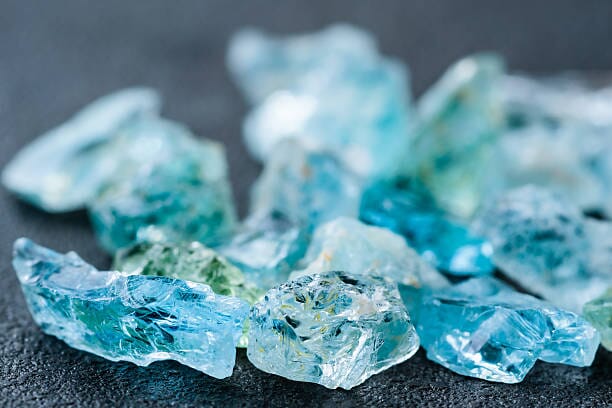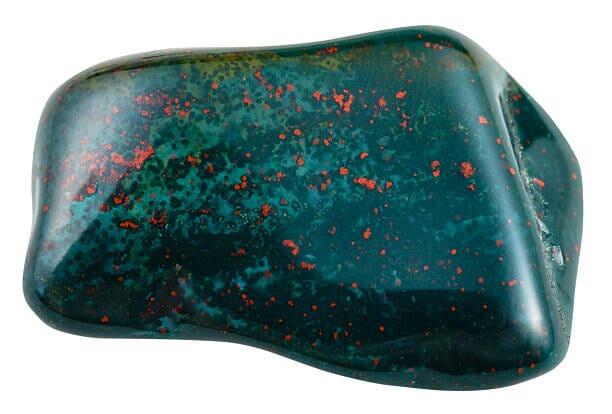Dive into the Gemstones of March – Aquamarine & Bloodstone
For all the lucky individuals that are born in the lovely beginning of spring, the month of March are blessed with two beautiful birthstones, aquamarine and bloodstone. Both these birthstones are distinctive in nature but they share a common property of taking care of an individual's welfare.
AQUAMARINE

Aquamarine is derived by the Romans terms 'aqua', which means water, and 'mare', which means sea. The serene sea is signified by the aquamarine through tranquil energy released by the gemstone. The tones of the sea are represented by the aquamarine birthstone. Intricate aquamarines vary in colour from vibrant green to a lighter tone, with others being more in a greenish blue. Aquamarine represents an expression of clarity as it purifies the soul and energy of the wearer through its purity like water.
Aquamarines are thought to have been originated from sirens' jewel caskets that washed up on shore from the sea. Neptune, the Roman god of the sea, regarded them as sacred. Because of its connection to the water, it became a sailor's treasure, guaranteeing successful and safe voyages by safeguarding them from sea danger. Between 480 and 300 BCE, the Greeks were the first to use the gemstone as they wore an aquamarine amulet depicting Poseidon (the Greek deity of the sea) riding in a chariot carved on them.
Aquamarines can be found in both primary (hard rock) and secondary (weathered) pegmatite deposits in the state's eastern region, near Teófilo Otoni, the state's gem hub. For the past two centuries, the Brazilian state of Minas Gerais has been a major producer of aquamarine. Aquamarine can also be discovered in Pakistan's Karakorum foothills. Miners must climb steep trails to elevations of approximately 9,800 to 13,000 feet to reach the deposits.
The significant part of owning a birthstone is taking proper care and maintenance to main the fine qualities of the Aquamarine. The simplest way to clean aquamarine is to take a bowl filled with warm water and add some dish washer soap. Soak the gemstone for a few minutes in the water bowl. Use a soft bristle toothbrush to gently scrub the aquamarine jewelry and clean any remaining debris or dirt. Thoroughly rinse the birthstone in warm water to make sure it is properly clean. Use a soft cloth to wipe the moisture on the birthstone and place it on a clean surface to allow it to completely dry.
Avoid all cleaning chemicals that contain ammonia or alcohol to prevent aquamarine from accidental damage during the cleaning procedure. Abrasive cleaning tools, such as rough scrubbing rags or hard brushes, should also be avoided. Clean the stone gently using gentle, nonabrasive products.

Bloodstone birthstone is a darkish green gemstone with red patches of iron oxide, which signifies the blood that provides well-being and vitality to the individual. The second gemstone, Bloodstone, is also called as heliotrope, is a specific type of quartz, which is an abundant mineral. Cryptocrystalline quartz is a type of quartz that consists of minute crystals that is microscopic in terms of visibility. Chalcedony is another name for this quartz type. Bloodstone is a type of green chalcedony with red specks. Bloodstone can be found as pebbles in riverbeds or imbedded in rocks. India, Brazil, and Australia are the greatest places to find this stone.
Bloodstone is a popular choice for religious carvings, mainly the Crucifixion. Around 1525, the Italian Matteo del Nassaro created a very notable carving. The sculptor meticulously created "The Descent from the Cross" such that patches of red on the bloodstone portrayed Christ's wounds and the drop of his blood. The bloodstone was made when a Roman soldier-guard stabbed his spear into Christ's side, causing drops of blood to fall on several dark green jasper stones resting at the bottom of the cross.
This stone was utilised by the Babylonians to produce inscriptions and amulets, and it was particularly popular among Roman gladiators. Bloodstone was thought to have medicinal properties in the Medieval Era, especially for halting nosebleeds. It was thought to treat
tumours and stop all forms of haemorrhage when powdered and combined with honey and egg white. It was utilised by ancient alchemists to cure blood abnormalities such as blood poisoning and injury.
This March birthstone is said to have a number of metaphysical healing characteristics. Enhanced strength, transparency, and the maintenance of an individual's good health. Fine bloodstones are grounded into a powder and used in India today. Bloodstone aids in the purification and eliminating of negative energy from one's aura and enables individuals become more mentally balanced.
The majority of bloodstone comes from India and can also be found in Brazil, Australia, China, and the United States, among other places.
Use warm soapy water along with soft bristle toothbrush to clean bloodstone. Avoid any use of harsh and abrasive cleanser or chemical on the birthstone. Store them in a dry and clean soft cloth to prevent them from any physical damage and dust.







